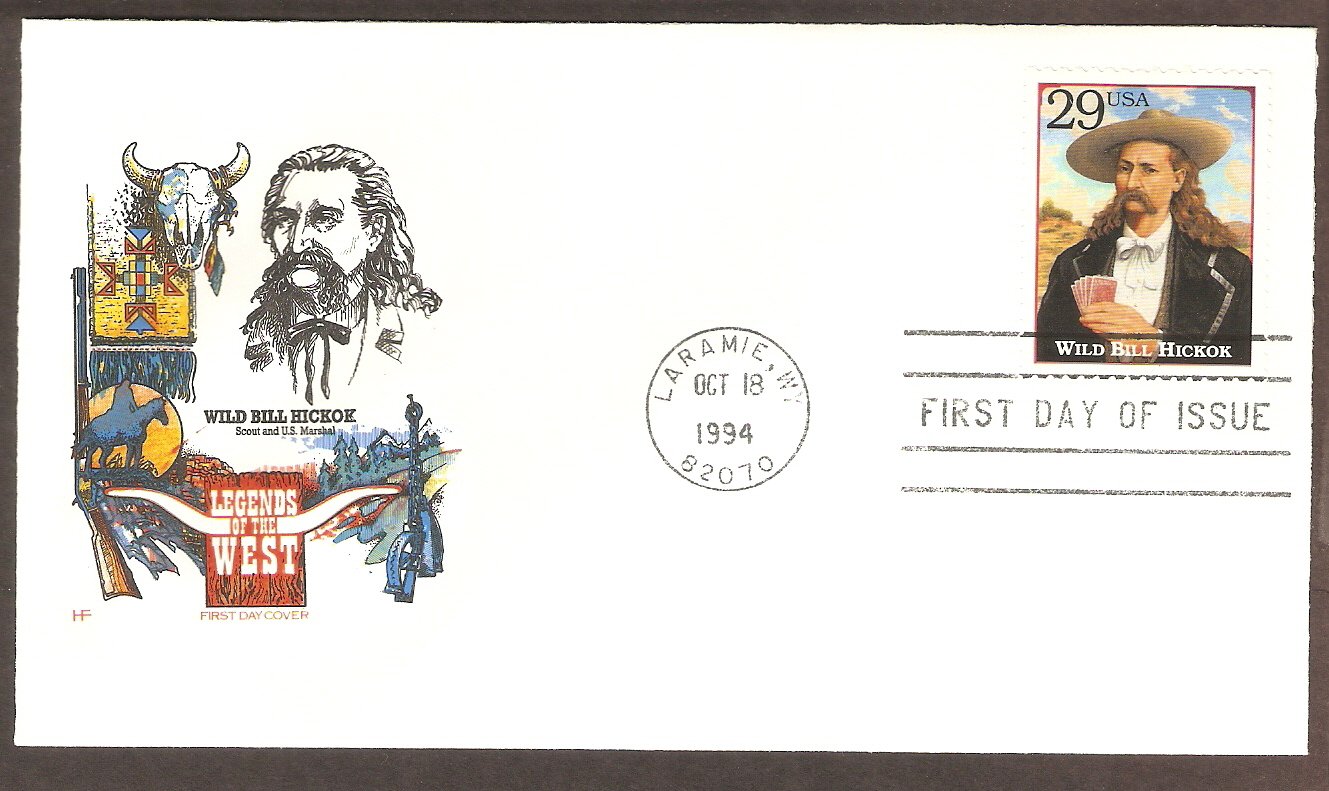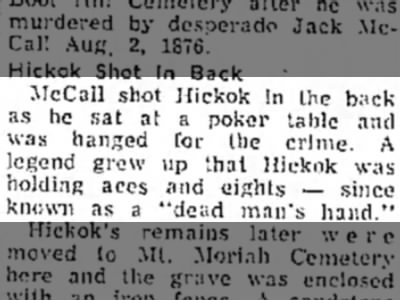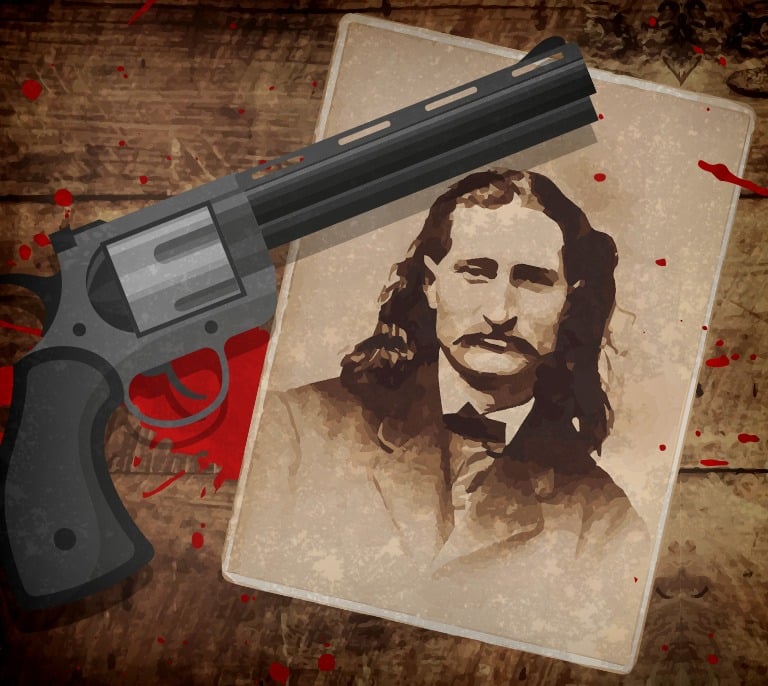Bill Hickok Poker Hand
That night, Hickok was playing poker at the Lyon House hotel when Tutt confronted him about a $35 debt from a previous card game. Hickok countered that the sum was only $25 and said he had a. The origin of Hickok’s Deadman’s Hand may be found in the correspondence between Ellis T. Peirce and Frank J. According to Peirce, “Bill’s hand read ‘aces and eights’ — two pair, and since that day aces and eights have been known as ‘the dead man’s hand’ in the western country.”.
The people on the platform recognized Wild Bill Hickok only by his long mustache, the collar of his long coat pulled up to his cheeks against the sharp wind blowing in over the falls. They didn’t dare approach. He looked angry. The train was late and his satchel kept blowing over. He wanted out of Niagara Falls as quick as possible. Acting was for fools, he thought.
He felt through his leather jacket and fingered the heavy piece of metal strapped to his side. The other actors made him take the bullets out of his pistol before he walked out in front of the audience. The costumes weren’t even right. The guy playing the Indian was a gypsy.
The Colt didn’t feel right without the bullets, but he did it and they paid him. He took the gun out in the daylight, snapped open the barrel and spun the chamber. He felt like squeezing the trigger a few times just to make some noise.
He couldn’t get any of the lines right. He could hear people snickering in the dark when he tried to say them. It was worse than facing a man holding a gun. That was easy. You just got to be faster and better-eyed. Talking, explaining, pretending; he didn’t even know why he agreed to do it, but never again.
He took a deck of cards out of his pocket and cut it with one hand, quickly, three times. He hoped he could encourage a few gentlemen to play stud on the train, all the way to Kansas. He hoped no one recognized him as the famous card playing lawman, but his picture was in every newspaper from here to New York City. He felt like fleecing someone.
His blonde-red mustache hung down to his chin like a Chinese laundryman and moved when he walked. For 39 men, this solemn face was the last they seen while breathing on this terrestrial planet. It only cost the passengers of the a few gold coins to sit with this folk hero, even if nobody knew it yet.
Hall of Fame
James Butler Hickok. Lawless lawman and card player. Killer of men. A sharpshooter who could pick a flea off the back of a buffalo from 500 yards away on a moving train. Reptilian cool, strong as an ox. Injun hater and Union spy.
And Poker Hall of Famer.
Hickok was inducted into the Poker Hall of Fame as part of the first class in 1979. That class, selected by Benny Binion, also contained Johnny Moss, Nick “the Greek” Dandolos, Red Winn, Felton McCorqudale, Syd Wyman, and Edmund “according to” Hoyle.
Before the poker explosion, the Poker Hall of Fame was simply a wall a pictures near the poker room at Binion’s Horseshoe. It was another way to get people in. Benny Binion knew Hickok as a card-playing folk hero who met his maker when a man shot him in the back of the head while playing poker. Hickok was wild west, and that fit nicely with the theme.
His last hand, aces and eights, is The Dead Man’s Hand. Somehow, it’s still spooky to play it.
Hickok became famous long before his death in Deadwood in 1876. He was only 39 when he died, but Hickok had packed the lifetimes of a dozen men in those years as a lawman, civil war scout and spy, and card player.
Poker made Hickok famous because it was during an ongoing poker game in Springfield, Missouri, in 1865. It was at a poker game when Hickok got into an argument with David Tutt, a man who hated Hickok because he thought he killed his brother during the Civil War. He also lost to Hickok the night before.
Tutt accused Hickok of owing him money. Hickok agreed he did, but said the amount was $25, not $35 as Tutt said. Hickok paid him $25, but Tutt grabbed his watch and left the hotel. The next day, Tutt wore Hickok’s pocket watch, flaunting it in front of what seemed to be the whole town of Springfield.
As Hickok put it later: “I won’t fight now unless I’m put upon.”
That is from a lengthy feature article printed in Harper’s New Monthly Magazine, Feb, 1867. It continues with a quote from a guy named Captain Honesty. The dialect is maintained.
“They say Bill’s wild. Now he isn’t any sich thing. I’ve know him goin on ter ten year, and he’s as civil a disposed person as you’ll find he-e-arabouts. But he won’t be put upon.”

The article was an immense profile called Wild Bill, complete with gorgeous illustrations of the wild man with the long mustache. Written by George Nichols, it instantly made Hickok one of the main faces of the wild and raw West, an image of a man people living in the east would conjure when thinking about the wild frontier.

According to Nichols, here was a man who killed at least 100 men, who escaped a barrage of bullets and swam across a river after his real identity was revealed to a Confederate Sargent, who knew the trails of the southwest better than any bone-wearing Indian, who was strong and hansom and never thought twice about the men he killed.
And he killed Tutt by standing directly in front of him during a dramatic duel that took place in Springfield’s town square. The two squared off and slowly leveled their pistols at one another. Tutt fired first and missed. Hickok fired and immediately turned toward the crowd.
Again, Captain Honesty tells Nichols what happened:
“Both Bill and Tutt fired, but one discharged followed the other so quick that it’s hard to say which went off first. Tutt was a famous shot, but he missed this time; the ball from the pistol went over Bill’s head. The instant Bill fired, without waitin ter see ef he had Tutt, he wheeled on his heels and pointed his pistol at Tutt’s friend, who had already drawn their weapons.
Aren’t yer satisfied, gentlemen? cried Bill, as cool as an alligator. ‘Put up yer shootin-irons or they’ll be more dead men here. And they put ‘em up, and said it war a far fight.”
This is seriously dramatic stuff even now and to the people living in the east, he was an American either never seen before or long forgotten about. It didn’t matter that several serious newspapers across the plains debunked many of the tales spun by Hickok in the Harper’s article, particularly the number of men Hickok killed, and his exploits during the Civil War.
Nonetheless, he was now famous and tried to capitalize on the Harper’s portrait to become an actor, like his old friend, Bill Cody, who was much better at showman ship than Hickok.
His first play was The Daring Buffalo Chasers of the Plains. He didn’t last long.
He hated it, moved to Kansas, and after losing an election for sheriff, he worked as a U.S. Marshal. By 1868, he became city marshal of Hays, Kansas, and sheriff of Ellis County, in part because no one else wanted the job.
Poker Sheriff
A hardcore card player, Hickok kept his office hours at local saloons and hotel rooms, where other games like liar’s dice were also played. This didn’t quite endear himself to the citizenry. A good poker session netted around $200 at the time and by all accounts, Hickok was a one of the best players around.
Hickok was most definitely a shoot-first-ask-questions-later kind of hothead. He shot and killed two men during his first two months on the job. He was part of multiple shoot-outs. He killed another man in 1870, and apparently that was enough for the city’s voters, who voted him out.
He became sheriff of Abilene, Kansas, where he immediately shot and killed two more men. One was a saloon owner, who painted a bull with an erection on the side of his Bull’s Head Tavern. Residents complained. During that gunfight, Hickok accidentally killed one of his deputies in panic.
He actually returned to the stage in 1873 with Bill Cody in a play called Scouts of the Plains, but he was making enough money as a card player while touring. He left the production sometime in 1876. He traveled around the west, occasionally speaking in theaters, but mostly playing cards.
Dead Man’s Hand
Every summer evening in Deadwood, South Dakota, (except Sundays), Jack McCall walks up to Wild Bill Hickok and shoots him in the back of the head. Then there’s a chase and a gunfight, McCall’s arrest, trial and hanging.
The chair Wild Bill died in is behind glass at the Town Hall.
Legalized gambling came to Deadwood in 1989. It was one of the first gambling markets to open outside of Nevada or New Jersey. Wild Bill Hickok, dead for 113 years, had a lot to do with it legalization.
The day Hickok died, he was playing five-card stud at the Nuttal and Mann’s Saloon. Legend has it that he preferred to always sit with his back against the wall, but no seats were available. He asked another player twice to change seats, but they refused.
McCall walked up behind Hickok and shouted “Damn you, take that,” splattering Wild Bill’s brains over the table and players. McCall’s motivation has been speculated as a gambling debt, a brother’s revenge, or as simple as an insult, but it’s lost to time.
The miners of Deadwood didn’t convict McCall, but he would be retried later in a U.S. court and was convicted of the murder of Wild Bill Hickok and sentenced to death by hanging.
In 1879, three years after he died, Hickok’s body was moved to another cemetery. According to the book They Called Him Wild Bill by Joseph Rosa, the body wasn’t embalmed properly and calcium carbonate leeched from the ground into Wild Bill’s body. It weighed more than 400 pounds.
He had turned to stone.
Hand in poker game which came out to be from an old west folk hero lawman and gunfighter Wild Bill Hickok who was murdered.
In today’s poker world the dead man’s hand is anickname for a particular poker hand, popularly a two-pair ofblack aces and black eights, although definitions of the hand have variedthrough the years. No contemporaneous source records this hand’s exact cards,but Frank Wilstach’s 1926 book Wild Bill Hickok: The Prince ofPistoleers led to the popular modern conception of the “dead man’shand” as containing pairs of black aces and black eights. In Hickok’s casethese would have been combined with an unknown hole card.
The history of the dead man’s hand
Over the years Dead Man’s Hand definitions have actuallychanged over the years, though. The earliest reference is thought to be in1886, where it was described as a full house of three jacks and a pair of tens.Then in 1903, the Encyclopedia of Superstitions, Folklore, and the OccultSciences of the World referred to it as a very unlucky hand of jacks andsevens. A little later in 1907, 17th century British author Edmond Hoyle,who wrote rule books for games to settle disputes, referenced it as jacks andeights.

The present the black aces and black eights definition onlycame around in the 1920s. That’s when it was solidified in poker vernacular, inlarge part because of a biography of Wild Bill Hickok: The Prince of Pistoleers.
Thestory goes that this hand actually comes from the death of lawman andgambler James Butler “WildBill” Hickok in 1876. He was killed by local drunkard, Jack “CrookedNose” McCall, in Deadwood, South Dakota. Apparently, after joining a pokertable with Hickok, he ended up losing every single dime. Hickock gave him somemoney to get some food and advised him not to play again until he could affordto cover his losses. McCall was insulted.
The next day, McCall entered the saloon to see Hickokplaying poker again and was furious. Hickok usually always sat with his back toa wall because he was paranoid about being killed, but on this fateful day hedidn’t because another player wouldn’t change seats with him.
McCall came up behind Hickok and allegedly shouted: “Damnyou! Take that!” and shot him in the back of the head with his Colt .45revolver. He claimed he was avenging his brother’s death.
Hickok died instantly, and McCall was executed by the stateseven months later. Most accounts say that Hickok’s hand at the time wascomprised of black aces and eights, although the Dead Man’s Hand 5th cardisn’t specified.
The worth of a Dead Man’s Hand in poker
While the Dead Man’s Hand might have a lot of psychologicaland historical value, it isn’t actually a very high valued hand and isconsidered unlucky. The two-pair, while not a terrible hand in poker, certainlyisn’t as worthwhile as a royal flush, straight or full house. While it’s alwaysintriguing to be dealt a Dead Man’s Hand, it doesn’t change your chances ofwinning or losing. Wikipedia states that it’s used as the insignia forthe Las Vegas Metro Police Department’s Homicide Division, theLA Police Department CRASH squad and the Armed Forces Medical Examiner System.
Now a sign of bad luck and death
In Ken Kesey’s book One Flew Over the Cuckoo’s Nest, McMurphy is described as having a tattoo of, “a poker hand fanned out across his muscle- aces and eights.” This foreshadows his eventual fate at the end of the novel.
Many poker fans often get the reference, presuming animminent death or at least an unwanted surprise in the future. In writtenfiction, it’s used in a variety of novels. For example, James Pattersonreferences it in Along Came a Spider, with a character telling the storyof how her father won his gun with a hand of aces and eights, and even uses theDead Man’s Hand as her computer password.
Wild Bill Hickok Poker Hand Images
Other news sources say that in One Flew Over the Cuckoo’s Nest, Ken Kesey describes McMurphy as having a Dead Man’s Hand tattooed on his shoulder, which has had various interpretations. Many fans of the book and film have taken inspiration for their tattoos from this.
John Ford used to use it as a foreshadowing of death in hisfilms. In Stagecoach, the hand is held by Luke Plummer before he is shotby the Ringo Kid, played by John Wayne. Then in The Man Who Shot LibertyValance, the titular character draws the Dead Man’s Hand just before his death.
As for TV show many have used this as titles of episodeswith imminent death or to show opportunities for characters to cheat death insome way. For example, in Criminal Minds, Hotch plays cards with a deathrow inmate in the hopes of getting the location of another victim. Hotch claimsto have a Dead Man’s Hand, which is what the inmate believes he should have.Hotch then reveals another ace, turning his Dead Man’s Hand into a full houseand beating his opponent.
Wild Bill Hickok Last Poker Hand
Even video games make use of this legendary hand. There’s an expansion for Fallout: New Vegas where players can collect cards making up the Dead Man’s Hand to get an achievement. In the card game Doomtown, the Dead Man’s Hand is the highest possible hand, using a jack of diamonds as the kicker. It features in Hearthstone, Werewolf: The Apocalypse, Wing Commander IVand Need for Speed: Carbon as well. Many music albums hit in market giving the reference the Dead Man’s Hand too. (From various news sources)